Oven-cooking pizza rolls offers a convenient and delicious way to enjoy a crispy exterior and gooey interior․ Follow these expert tips for perfect results every time․

Understanding the Basics of Cooking Pizza Rolls in the Oven
Cooking pizza rolls in the oven requires attention to temperature‚ timing‚ and arrangement․ Preheating to 425°F ensures even cooking‚ while spacing rolls evenly prevents overcrowding and promotes crispiness․
Importance of Following Oven Instructions
Following oven instructions ensures food safety‚ quality‚ and optimal flavor․ Cooking pizza rolls to an internal temperature of at least 160°F prevents undercooking and foodborne illness․ Overcooking can lead to burnt or dry rolls‚ while undercooking may result in a soggy texture․ Adhering to recommended temperatures (typically 425°F) and times (around 12-14 minutes) guarantees crispy exteriors and gooey interiors․ Proper spacing on the baking sheet and monitoring during cooking also prevent overcrowding and uneven baking․ This attention to detail enhances both taste and texture for a satisfying snack․
Key Components of Oven Cooking for Pizza Rolls
Oven cooking for pizza rolls requires attention to temperature‚ timing‚ and arrangement․ Proper preheating ensures even heat distribution‚ while spacing the rolls evenly prevents overcrowding․ Using a baking sheet lined with parchment paper or lightly oiled helps prevent sticking․ The middle rack is ideal for consistent cooking․ Optional additions like garlic butter or seasonings can enhance flavor․ Maintaining the recommended temperature (typically 400-425°F) and cooking time (12-14 minutes) ensures crispy exteriors and fully cooked interiors․ These elements work together to achieve perfectly baked pizza rolls․

Oven Temperature and Preheating Guidelines
Preheat the oven to 400°F–425°F for pizza rolls․ Proper preheating ensures even cooking and prevents undercooked or unevenly baked rolls‚ enhancing the final texture and flavor․
Recommended Oven Temperature for Pizza Rolls
The ideal oven temperature for cooking pizza rolls is between 400°F and 425°F․ This range ensures the rolls bake evenly‚ with a crispy exterior and a soft interior․ A lower temperature may result in undercooked rolls‚ while too high a heat can cause burning․ Always refer to the package instructions for specific temperature recommendations‚ as some brands may vary slightly․ Proper temperature control is key to achieving the perfect texture and flavor for your pizza rolls․
How to Properly Preheat the Oven
To ensure your pizza rolls cook evenly‚ preheating the oven is essential․ Set the oven to the desired temperature and allow it to preheat for 10–15 minutes․ This allows the oven to reach a consistent heat‚ preventing undercooked or unevenly baked rolls․ Avoid skipping this step‚ as it directly impacts the cooking results․ Once preheated‚ place the pizza rolls in the oven immediately to achieve the best texture and flavor․ Always monitor the oven to maintain the correct temperature throughout the cooking process․
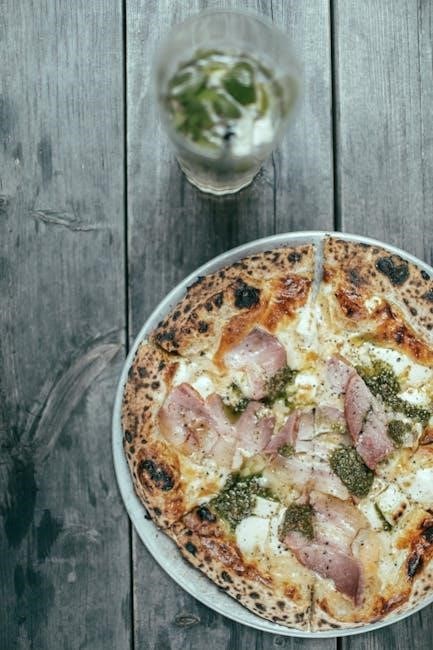
Preparing Pizza Rolls for Oven Cooking
Place pizza rolls on a baking sheet lined with parchment paper‚ leaving space between each roll for even cooking․ Brush with butter or oil for crispiness if desired․
Thawing vs․ Cooking Frozen Pizza Rolls
When preparing pizza rolls‚ you can either thaw them first or cook them frozen․ Thawing ensures even cooking but may make rolls soggy‚ while cooking frozen retains crispiness․ For best results‚ bake frozen rolls directly on a preheated baking sheet․ If thawed‚ pat dry excess moisture to avoid sogginess․ Both methods yield delicious results‚ so choose based on your preference for texture and convenience․
Arranging Pizza Rolls on a Baking Sheet
When arranging pizza rolls on a baking sheet‚ leave about 1 inch of space between each roll to ensure proper air circulation․ This prevents them from sticking together and promotes even cooking․ Place the rolls seam-side down to minimize the risk of bursting during baking․ For easier cleanup‚ line the baking sheet with parchment paper․ Avoid overcrowding‚ as this can lead to uneven cooking․ If needed‚ use multiple batches to accommodate all rolls․ Proper arrangement ensures crispy exteriors and fully cooked interiors․
Cooking Time and Internal Temperature
Cooking pizza rolls typically takes 12-15 minutes in a preheated oven at 400°F (200°C)․ The internal temperature should reach 160°F (71°C) for optimal doneness․ Check for a golden brown appearance for the best results․
Standard Cooking Time for Pizza Rolls
Cooking pizza rolls in the oven typically takes 12-15 minutes at 400°F (200°C)․ However‚ this time may vary slightly depending on oven performance and roll size․ For smaller rolls‚ check after 10 minutes‚ while larger ones might need up to 18 minutes․ Ensure even cooking by rotating the baking sheet halfway through․ A golden-brown crust and crispy exterior indicate they are fully cooked․ Avoid overcooking‚ as this can lead to dryness․ Always refer to the package instructions for specific guidelines‚ as brands may differ․
Ensuring Proper Internal Temperature
To ensure pizza rolls are fully cooked‚ check their internal temperature using a food thermometer․ The ideal internal temperature should reach 160°F to 165°F (71°C to 74°C)․ This ensures the dough is cooked through and the filling is heated evenly․ Avoid relying solely on appearance‚ as golden-brown rolls may not always indicate doneness․ Use the thermometer to pierce the center of a roll gently․ This step is crucial for food safety and achieving the best texture and flavor․ Proper temperature control prevents undercooked or overcooked rolls․
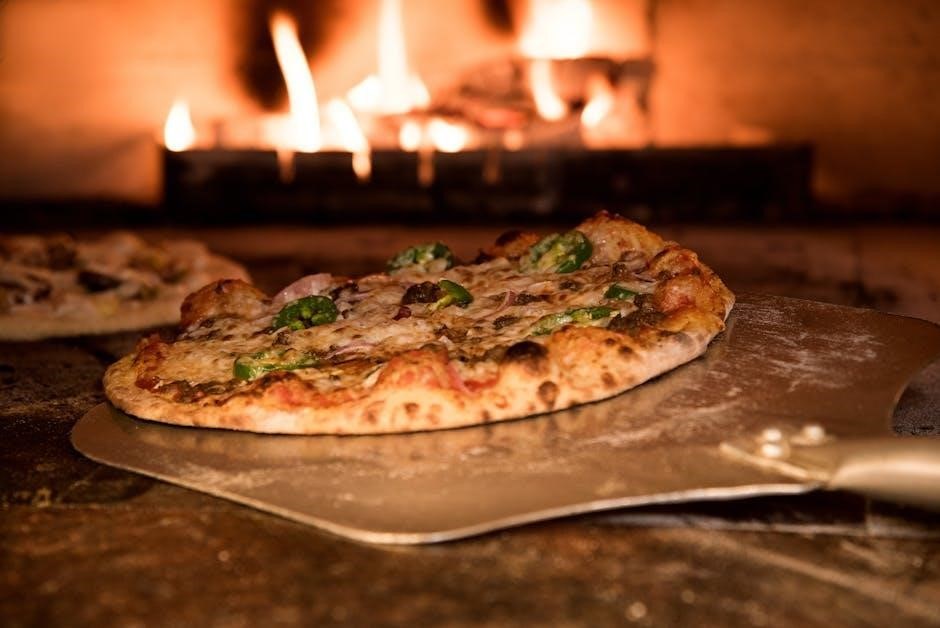
Tips for Even Cooking and Prevention of Bursting
Poke pizza rolls with a fork before baking to prevent bursting․ Arrange them in a single layer on a parchment-lined baking sheet for even cooking․
How to Prevent Pizza Rolls from Bursting in the Oven
To prevent pizza rolls from bursting‚ poke each roll with a fork a few times before baking․ This allows steam to escape during cooking․ Place the rolls seam-side down on the baking sheet to minimize bursting․ Ensure they are frozen when placing them on the sheet‚ as thawed rolls are more prone to bursting․ Avoid overcrowding‚ as this can cause uneven cooking and increased pressure․ Line the sheet with parchment paper for easier cleanup and to prevent sticking․ Bake at the recommended temperature to ensure even cooking and reduce the risk of bursting․
Ensuring Even Baking
For even baking‚ arrange pizza rolls in a single layer on the baking sheet‚ leaving about 1 inch of space between each roll to allow proper air circulation․ Rotate the baking sheet halfway through the cooking time to ensure uniform baking‚ especially in ovens with hot spots․ Placing the rolls on parchment paper can also help them bake evenly and prevent sticking․ Avoid overcrowding‚ as this can lead to uneven cooking and some rolls being undercooked while others are overcooked․ Consistent spacing and rotation are key to achieving perfectly baked pizza rolls․
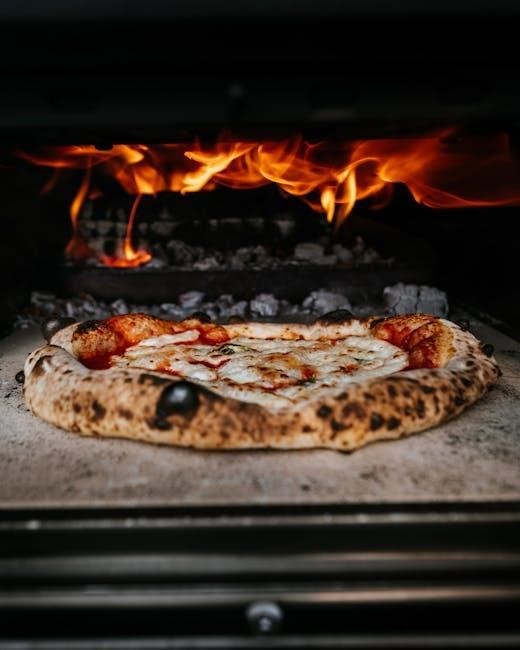
Optional Enhancements for Oven-Cooked Pizza Rolls
Add butter or oil for crispiness‚ or season with herbs and spices before baking for extra flavor․ These simple touches elevate oven-baked pizza rolls․
Adding Butter or Oil for Crispiness
For a crispy exterior and golden finish‚ brush pizza rolls with melted butter or a light layer of oil before baking․ Olive oil or avocado oil works well for a savory touch‚ while butter adds a richer flavor․ Gently coat each roll using a pastry brush or drizzle oil over the baking sheet․ This step enhances browning and texture‚ ensuring your pizza rolls come out crunchy on the outside and soft within․ For extra flavor‚ sprinkle with garlic powder or Italian seasoning before baking․
Seasoning Pizza Rolls Before Baking
Enhance the flavor of your pizza rolls by seasoning them before baking․ Sprinkle with Italian seasoning‚ garlic powder‚ or dried oregano for a classic taste․ For a spicy kick‚ add a pinch of red pepper flakes․ Lightly toss the rolls in a bowl with the seasonings to ensure even distribution․ This step adds depth to the flavor without overpowering the natural taste of the rolls․ Seasoning before baking ensures the flavors meld perfectly during cooking‚ creating a delicious and aromatic snack․
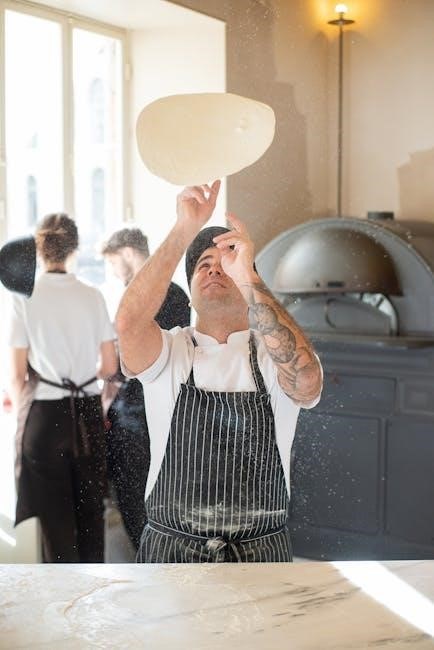
Common Mistakes to Avoid When Cooking Pizza Rolls
Overcrowding the baking sheet‚ incorrect oven temperature‚ and overcooking are common mistakes that can lead to uneven cooking or burnt pizza rolls․ Avoid these for best results․
Overheating and Burning
Overheating is a common issue when cooking pizza rolls in the oven‚ leading to burnt exteriors and undercooked interiors․ This often occurs due to high oven temperatures or extended cooking times․ To prevent burning‚ ensure the oven is preheated to the recommended temperature and monitor the pizza rolls closely during the cooking process․ Signs of overheating include darkened edges or a hard‚ crispy texture․ Adjusting the cooking time and using a lower temperature can help achieve perfectly cooked‚ golden-brown pizza rolls without burning․
Overcrowding the Baking Sheet
Overcrowding the baking sheet is a common mistake that can lead to uneven cooking and poor results․ When pizza rolls are placed too close together‚ they may steam instead of bake‚ resulting in a soft texture rather than a crispy exterior․ To avoid this‚ arrange the pizza rolls in a single layer with adequate space between each roll․ This allows proper air circulation‚ ensuring even cooking and preventing the rolls from sticking together․ For larger batches‚ consider cooking in multiple smaller groups․
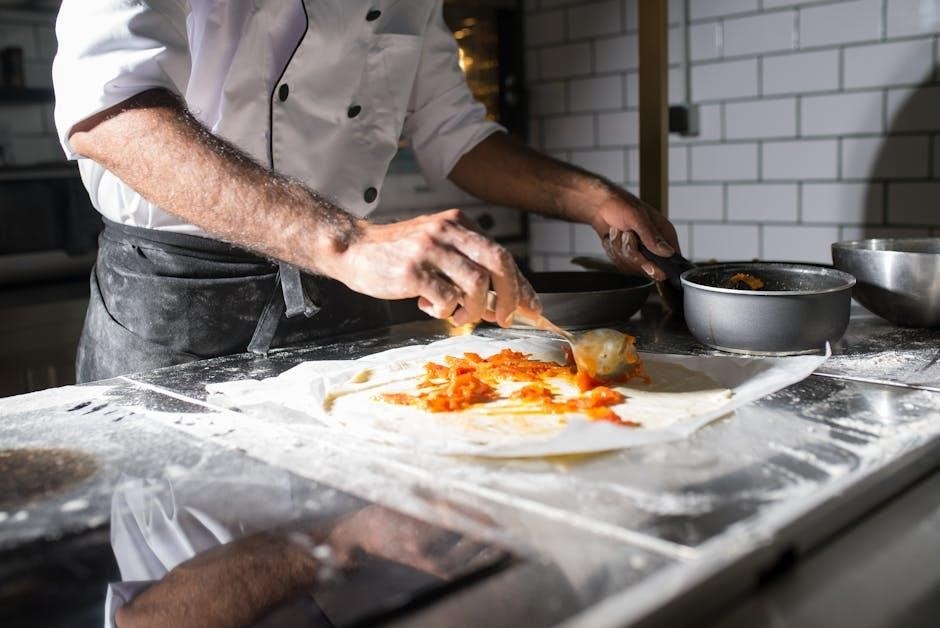
Alternative Cooking Methods Compared
Alternative cooking methods like air fryers and toaster ovens offer faster cooking times and crispier results compared to traditional ovens‚ but may lack even heat distribution․
Toaster Oven vs․ Conventional Oven
When comparing toaster ovens and conventional ovens for pizza rolls‚ toaster ovens offer faster preheating and cooking times due to their smaller size․ They also use less energy and can achieve a crisper exterior․ However‚ they may lack space for large batches․ Conventional ovens provide more room for even cooking but require longer preheating and may not crisp as well․ Choose based on batch size and desired texture for optimal results․
Air Fryer vs․ Oven Cooking
Air fryers and ovens differ significantly in cooking pizza rolls․ Air fryers use less oil‚ cook faster due to rapid air circulation‚ and produce a crispy texture․ Ovens‚ while effective‚ require more time and space․ Air fryers are ideal for smaller batches and healthier options‚ while ovens suit larger quantities․ Both methods yield delicious results‚ but air fryers offer convenience and crispiness without extra oil‚ making them a popular choice for pizza rolls․

Safety Tips for Cooking Pizza Rolls in the Oven
Always monitor the oven to prevent overheating and use oven mitts or tongs for safe handling․ Keep children away from hot baking sheets and ovens․
Monitoring the Cooking Process
Monitoring the cooking process is crucial to ensure pizza rolls are cooked evenly and safely․ Set a timer according to recommended cooking times and check the rolls near the end to prevent burning․ Use oven mitts or tongs to carefully remove a roll for inspection․ Look for golden-brown color and a crispy exterior․ Keep the oven light on to observe without opening the door too often․ This helps maintain consistent heat and prevents undercooking or overcooking․
Handling Hot Baking Sheets
Always handle hot baking sheets with care to avoid burns; Use oven mitts or tongs to remove sheets from the oven․ Place them on a heat-resistant surface‚ like a trivet or cooling rack․ Never leave hot sheets unattended‚ especially near children․ Allow sheets to cool slightly before transferring pizza rolls to a serving plate․ This ensures safety and prevents accidental burns․ Proper handling helps maintain kitchen safety and makes the cooking process more efficient․
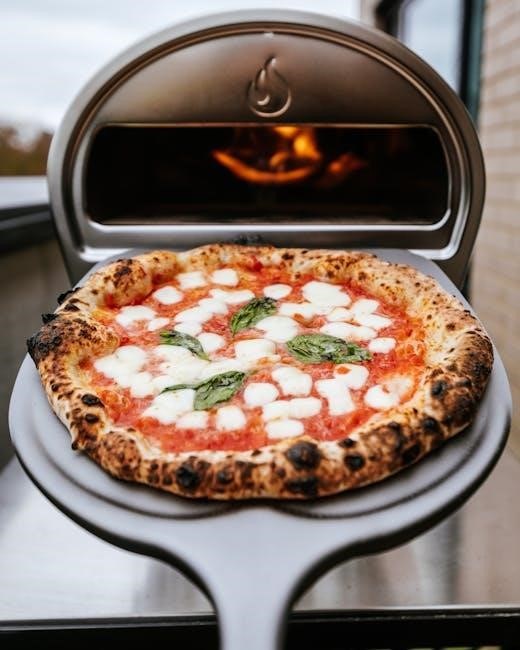
Storing and Reheating Cooked Pizza Rolls
Store cooked pizza rolls in an airtight container in the fridge for up to three days․ Freeze for longer storage․ Reheat at 350°F for 5-7 minutes․
Proper Storage of Cooked Pizza Rolls
Cooked pizza rolls should be stored in an airtight container to maintain freshness and prevent drying out․ For short-term storage‚ keep them in the refrigerator for up to three days․ For longer storage‚ place them in a freezer-safe bag or container and store in the freezer for up to three months․ Ensure the container is sealed tightly to avoid moisture exposure․ Let rolls cool completely before storing to prevent condensation buildup․ Avoid leaving cooked rolls at room temperature for extended periods‚ as this can lead to spoilage․
Reheating Pizza Rolls in the Oven
To reheat pizza rolls in the oven‚ preheat it to 350°F (175°C)․ Place the rolls on a baking sheet lined with parchment paper‚ leaving space between them for even heating․ Cover with foil to prevent drying․ Bake for 10-12 minutes until warmed through․ For crispiness‚ remove foil for the last 2-3 minutes․ Avoid overcrowding the sheet‚ as this can lead to uneven reheating․ Reheated rolls are best enjoyed immediately for optimal flavor and texture․
Cooking pizza rolls in the oven is a convenient and delicious way to enjoy this tasty snack․ By following the guidelines on temperature‚ time‚ and arrangement‚ you can achieve perfectly cooked rolls every time․ Always prioritize even baking and proper internal temperature for safety and flavor․ Whether you’re reheating or cooking from frozen‚ the oven offers consistent results․ Experiment with optional enhancements like seasonings or butter for extra crispiness․ With these tips‚ you’ll master oven-cooked pizza rolls and satisfy your cravings effortlessly!
